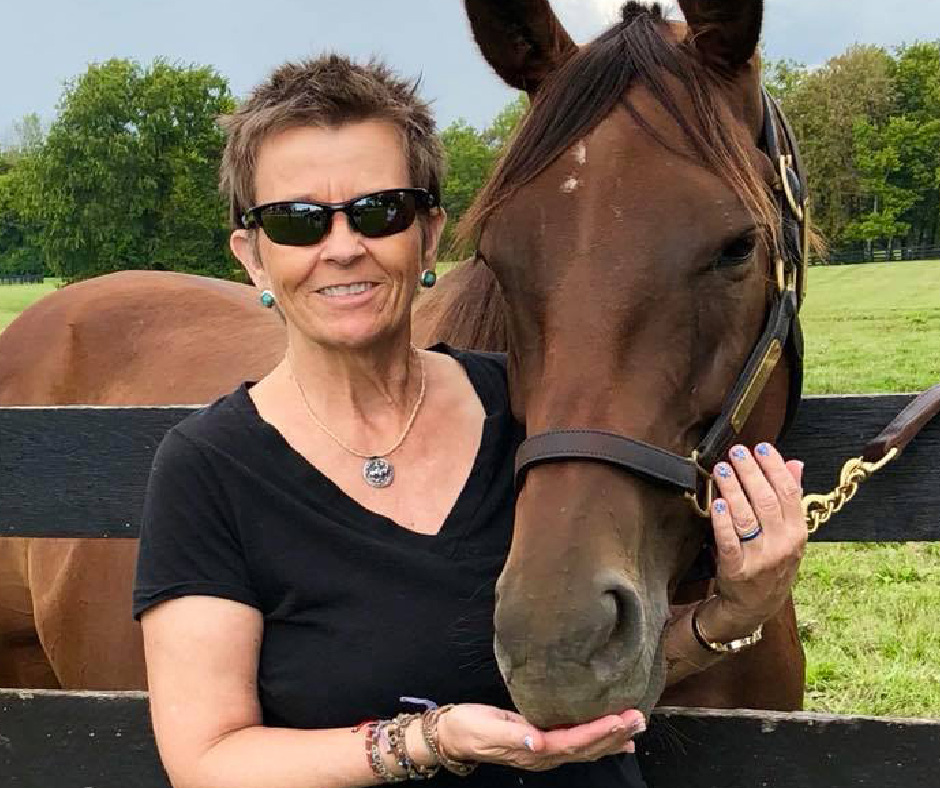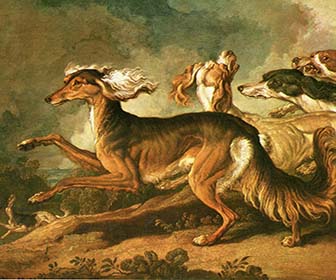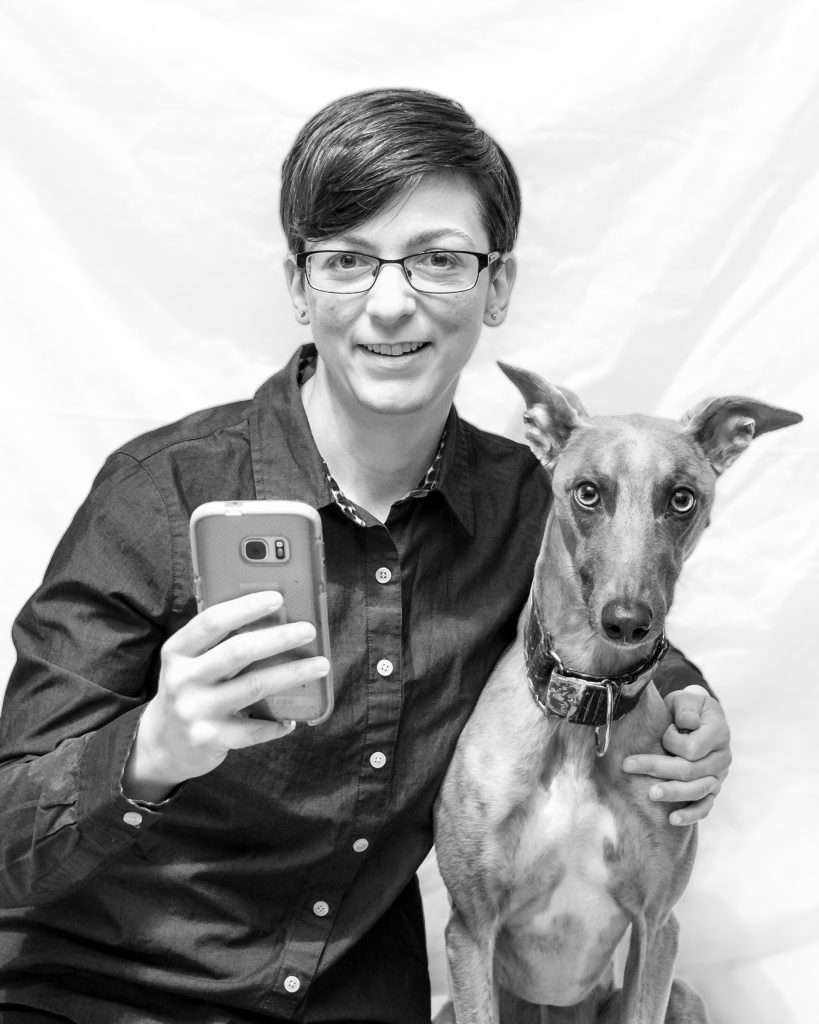643 — Bo Bengtson on Whippets and His Newest Book
Host Laura Reeves is joined by Bo Bengtson, legendary breeder, judge and author of The Whippet: An Authoritative Look at the Breed’s Past, Present and Future.
Questions for Bo:
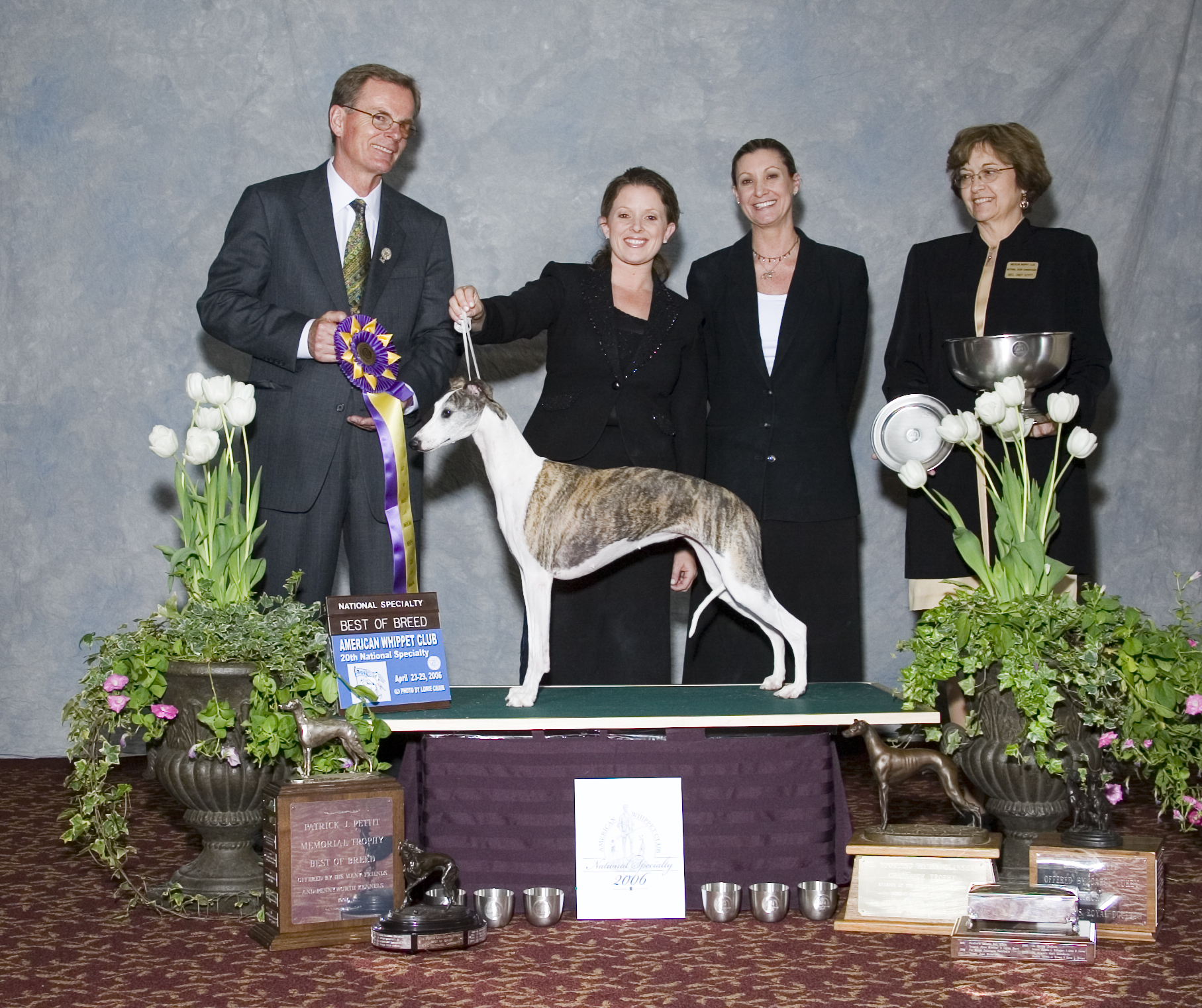
Bo Bengtson judging the American Whippet Club National Specialty.
1) This is your fourth edition of the quintessential book, “The Whippet,” first published in 1985. What made you want to update it again? What will readers find that is new?
I guess it’s pretty unusual for a dog book that was published that long ago to be reprinted, but it was last published in a much enlarged edition in 2010 and so much has happened in Whippets in the last 15 years! Whippets have become one of the most popular breeds at many shows: Crufts in England has had about 400 for the last few years, only Labs and Goldens have more… I have judged a show with 250 Whippets in Sweden, they have a Sighthound show in Germany that has 235 Whippets as a top figure, and it has become amazingly popular in many countries where you wouldn’t necessarily expect it: the big shows in e.g. Poland all have more than 100 exhibits NOW. The 2024 FCI World Dog Show was held in Croatia last month and there were 171 Whippets entered, which is fairly typical figure for the World Shows. And there are over 6,000 entries from the Czech Republic alone to the Internet’s Whippet Archive, so that’s probably the next big Whippet country!
USA doesn’t have the biggest registration figures, but the American Whippet Club holds a National Specialty in April every year that is the largest in the world, sometimes with more than 600 Whippets present and over 1,200 entries. I made a point of including all countries that have affected the world population in some way. Did you know that there is a world class Whippet breeder in South Korea that often wins in Europe and works with American bloodllines?
I read parts of that 1985 book recently … It’s not a bad little book for its time and a lot of the content is in later editions also, but it’s fairly typical of breed books then, both in scope and size. Not many photos and all black and white, but I’ll always remember how proud I was to get into Foyles Bookstore on Charing Cross Road in London and seeing my book on the shelf there!
To get back to the new book, I’m so grateful that Denise Flaim convinced me to update it! The book is available both on Amazon and via Denise’s RevodanaPublishing.com —they did a beautiful job: the book is much bigger than I expected — I don’t know why I didn’t expect that because I know that we added a lot of text and about 200 photos of winners from the last 15 years. Anyway, it weighs about 3.25 pounds, covers 530 pages, and when I took an advance copy to the National specialty in Tennessee in April, one reader actually started to cry because it was so beautiful!!
2) Share with our listeners some of the fascinating breed history you have gathered over the years, from its humble beginnings hunting hares, to its popularity as “the poor man’s greyhound,” to today.
Well, of course the Whippet became popularly known as the favorite dog of the poor mining families in the North of England in the 1800s. There was organized racing with considerable sums to the winners, so of course the dogs were really well taken care of and in fact fed much better than the people. What’s really amazing is how many people turned out to watch the races: there are some grainy black and white films still in existence from the late 1800s, and they prove beyond a doubt that there were thousands of spectators, many thousands.
But what I’ve found was that the Whippet had friends much higher up on the social ladder as well. Gertrude, the Lady Decies, was socially very prominent and owned several champion Whippets, including the two first brindle champions. She was primarily a cat fancier, breeder and exhibitor but she showed the dogs herself, in post-Victorian voluminous skirts and cartwheel hat. And there was also Sir Edmund Chaytor, Bart., who was a frequent exhibitor with Lady Chaytor and helped reorganize the Whippet Club after the first World War.
There are even some royal connections: in Kitty Kelly’s biography of the British royal family there is a previously unknown photo of Queen Mary with three of her sons, dating from perhaps 1910, which has a very good-looking Whippet in it: I have not been able to find out the name of the dog, but Queen Maud of Norway, who was born in England and granddaughter of Queen Victoria, was often photographed with her Whippets.
So I think that the Whippets has gotten a somewhat unfair rap for appealing only to one particular segment of society while in reality it was appealing both to high and low.
3) Talk about the Whippet internationally and the cooperation amongst breeders that has made it one of the deepest in quality globally.
There are differences between the standards in U.K. and in the U.S., but they are not greater than that a really good dog can win in both countries. The days when you almost needed an English Champion to win in the U.S. are long since gone, and the English added some American blood since then, which was quite successful, but mostly they import from Continental Europe these day – and Europe is full of fantastic Whippets of part English and part American breeding these days … The Europeans are almost more American than we are in the U.S. — and they LOVE American imports!
I must give shout-out to Italy, which has some wonderful Whippets and probably five or six word-class breeders, and Holland, who has a long history in the breed and currently houses Europe’s probably most successful stud dog, — who was born in South Africa of part British and part American background. The most successful breeder in England actually lives in Holland!
4) What other factors can you identify that account for the depth and breadth of quality in the breed?
I mentioned the Internet’s Whippet Breed Archive earlier; it has more than 372,500 pedigrees online — I just checked! — many of them illustrated. It’s an incredibly important tool for both novices and longtime fanciers like me, and everybody uses it. You can find statistics, both current and from the past, about things like population, color distribution, health, and the most popular sires, and you can even make up mock pedigrees for planned litters. I really think the success of the Whippet Breed Archive has been the success of the whole breed world-wide!
And there are so many different competitive outlets for Whippets, which probably accounts for much of the activity in the breed and explains why we lose so few new fanciers. You can focus on conformation, of course, but there are also field activities that you can participate in: racing or coursing, and we always have a couple of days of field activities during our national specialties, and sometimes there are the same dogs who participate. There were 200 entries in the coursing alone at the 2024 National, and 50 of them were conformation champions! And at the National Specialty there are invariably special classes for those who are racing or coursing qualified, and a special award to the winner of Best Performance Dog. Then you can of course participate in obedience or rally, like hundreds did at our last national specialty. And there are always well-filled Versatility and Triathlon classes!
5) What are Whippet breeders doing that the rest of the purebred dog fancy could learn from?
The fact that we have a really great, large and strong National Specialty is really important, I think. The Whippet people more or less take over a hotel or motel in a different part of the country in April every year, and beyond national specialty judging there is so much going on that there is no way you can participate in everything: there’s racing and coursing, Breeder’s Sweepstakes, Veteran’s Sweepstakes, Futurity, Top 20, health testing, judges education, parades of Honors and Rescues … and probably even more that I’ve forgotten, like obedience, agility and rally. … It gives people something to focus on; I’m really sorry for the breeds that don’t have a great National Specialty.
And it probably helps that we are as a group generally NICE! There are some exceptions, of course, but when I hear what goes on in some other breeds I am so grateful that I’m in Whippets! I doubt that anybody would refuse to let their stud dog be used on some bitches because they just happen to be owned by the “wrong” people, and if someone would like to buy a promising show puppy from another kennel, just let them. There is the usual grumbling about the wrong winners, of course, but I bet there’s less rancor and bad feelings in Whippets than in most breeds. We really try to be happy for each other when somebody is winning, even if it isn’t what we would have done if we were judging,
6) Can you identify and talk about three quintessential, iconic “lines” or families or kennels of Whippets, either standing alone or working together, that have most influenced the modern breed?
English Laguna: a son of the great stud dog Laguna Ligonier was sent over to the U.S. in the 1960s, Greenbrae Barn Dance, and basically created the American Whippet. He was an incredibly strong sire for his own elegant type, and his litter brother was exported to Canada: the sheer beauty of these dogs and their offspring was overwhelming; they were saved from an over-refined appearance by the strength of the Stoney Meadows more genuinely American line — bred by Mrs. Wear, Doris Wear.
And of course there was Peggy Newcombe and her Courtenay Fleetfoot of Pennyworth, who did wonderful PR for the breed by winning BIS at Westminster and being No. 1 dog of all breeds.
Later there was Ch. Delacreme De La Renta, who was a terrific sire, and his grandson Ch. Starline’s Reign On: both have sired well over 100 champions each, and Reign On is in the news again now for having sired many more champions in a couple of litters by A.I.
We are lucky to have so many clever breeders in pretty much all areas of the country, which makes it difficult to win with mediocrity anywhere. Sporting Fields has bred many litters, often in partnership with other breeders, but they have the number of champions for it, and six Sporting Fields dogs have won the National Specialty! Or seven if you count Ch. Bo-Bett’s Air Force One, who won in 2023 – he was officially co-bred by the late Carol Harris with Debbie Butt and her daughter Amanda Giles.
There are so many other kennels and stud dogs that have had breed-changing influence, like Starline and Chelsea and Plumcreek and Saxon Shore that it’s impossible to mention them all.
7) You have judged all over the world for decades. Name three dogs you have seen that you most admired and what made them stand out in your mind. Of the many beautiful Bohem whippets you’ve bred, which was your favorite?
Oh, that’s very difficult … Some of the dogs I’ve put up in Europe and Australia have been wonderful, but the best Whippet I’ve judged remains Ch. Brushwood’s Moxi of Endeavor in the U.S., who’s a perfect balance of elegance and strength. She should have won many more BIS than she did, but she won the AWC National three times, once under me.
I haven’t judged the Crufts BIS winner Ch. Pencloe Dutch Gold, who was wonderful and whom I got the opportunity to go over when he was shown not for competition when I judged a specialty in Scotland the same year he had won Crufts. He was so much more exciting than his pictures!
Nor have I judged GCh. Pinnacle Kentucky Bourbon, just admired her from ringside — I can still remember how enthusiastic some breeder-judges whom I really respect were about Bourbon when they had put her up at specialties before she was famous and had won more than a hundred BIS at all-breed shows.
By FAVORITES I have bred, I assume you mean by conformation? I haven’t bred a lot, but I must mention a dog I bred in Sweden long ago, Int. Ch. Bohem Mome Rath — most of the dogs we bred then don’t hold up today but he really does. Such a pity that I have nothing left of him; he was hardly used at stud at all and was owned by a teenage girl who was not easy to deal with and kept him way too fat! But she redeemed herself by later telling me how much she loved him when I had moved to the U.S., so that was OK.
The other dog that I’m really proud of is Ch. Bohem C’est la Vie, who had a short but brilliant career shown by my partner Paul Lepiane, who’s an excellent handler. He won both all-breed and specialty BIS with her but she remains famous mostly because she was lost at JFK Airport in the early 2000s and thousands of people spent months trying to find her until the NY Times declared her an “urban legend”… She was never found, but fortunately I had bred her young, and through her son she’s behind everything that came later.
ADDITONAL QUESTIONS (if there is time)
8) What other books have you written?
I wrote my first dog book when I was 22, so that’s a while ago — 58 years to be exact —and there have of course been a few books since then … I wrote a breed encyclopedia that I wasn’t particularly happy with, so I sold all the rights to it back to the publisher for not very much money … whereupon it was published in lots of languages and sold half a million copies! That would have been some nice royalties for me, but of course I got nothing and in fact only saw the book once after that — in a book-store window when I was judging in Brazil!
But I did write one other book that was good: it was called “Best in Show, The World of Show Dogs and Dog Shows” and was published in 2008, so it’s not exactly current. I worked on it for at least a couple of years and tried to make it as world-encompassing as possible and historically correct as possible. It has all the biggest winners of all the different breeds in the world in it and photos of most of them!
Dog shows had an early beginning in the 18th Century and descend one the one hand from shooting and hunting people and one the other hand from the rat catchers in the pubs of London: eventually these were considered offensive and gave rise to more humane activities, including clubs for “fancy dogs.”
But that book was never promoted as it should have been. It got wonderful reviews and won some awards, but I think the people who had worked on it with me were all fired, so nobody was left at the publisher who knew what it was about. I think it still is available on Amazon for about $20.
9) Why are you focusing so much on the past?
Well, because history is so fascinating, of course! I did’t think so when I was younger, and almost no younger person thinks so, so maybe you have to be kind of a historical artifact yourself to appreciate history? You can never know exactly what went on as recently as e.g. 100 years ago, because although people haven’t changed that much, in some respects people were different then — but you can read the remaining reports and guess what was meant by them.
I’m sure that many contemporary dog fanciers think that my fascination with the past is at least a little weird. Nobody can foresee the future, but as Churchill or someone said, “If you want to know about the future it helps to know the past …”
617 – Breed Type First: Mary Dukes on Judging Dogs
Breed Type First: Mary Dukes on Judging Dogs
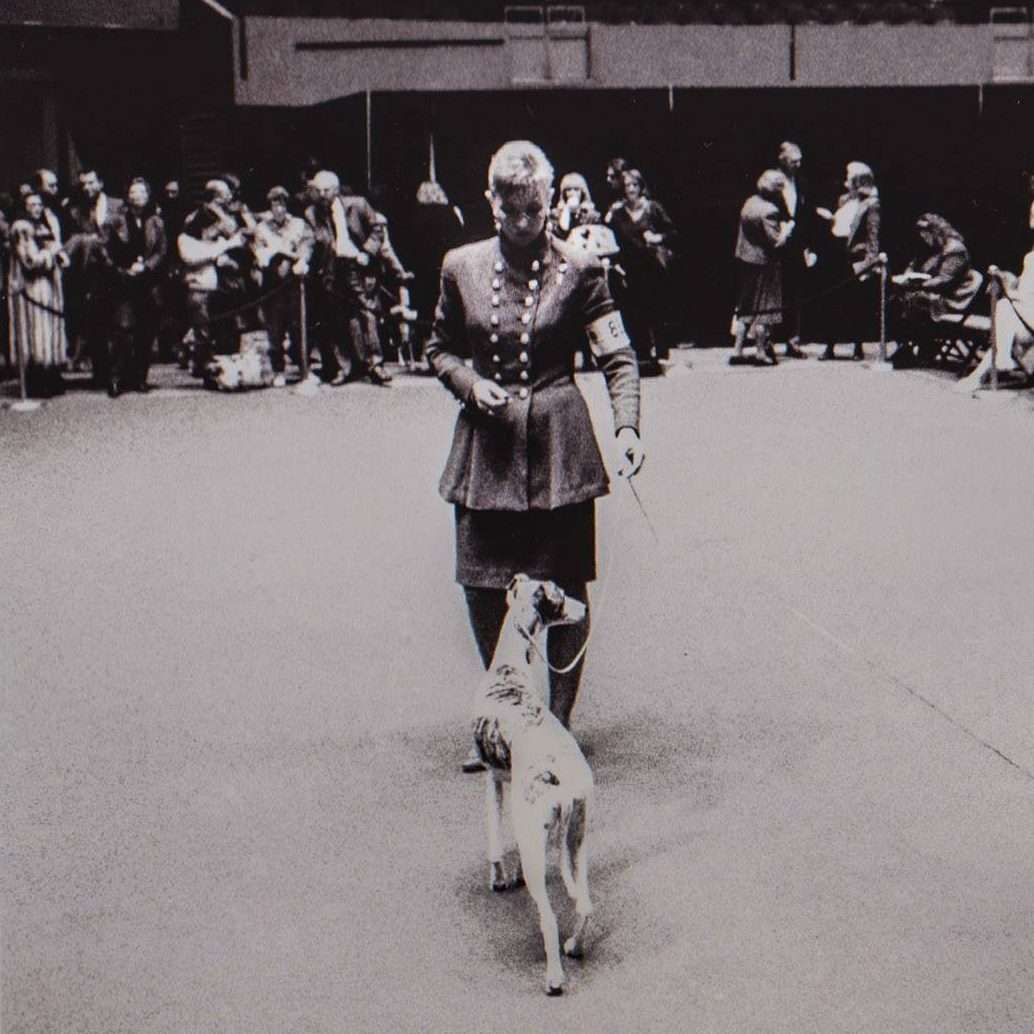
Mary Dukes in her handling days heyday.
Legendary handler, rep and now judge Mary Dukes continues her conversation with host Laura Reeves. Today they talk about judging, handling and all-time favorite dogs.
“I’m a type-first girl all the way,” Dukes said, quoting the notable Anne Rogers Clark common wisdom to sort first on type and then reward the soundest of the typical dogs. “I’m forgiving of leg faults, especially on the down and back. As long as it doesn’t offend me, it’s probably good enough.
“I do firmly believe this. A good judge can see right through a poor handling job. Sometimes it’s frustrating. I watched a breed in Orlando. It wasn’t a hound breed but a breed that I’m very familiar with and it was so frustrating because it’s an owner -handled breed for the most part and the best dogs in there were being tragically handled. It was so frustrating because there was a dog in there that’s beautiful and every time the judge looked at him (the handler) wasn’t even trying to do anything with him. His legs were everywhere. You know, all she was doing was feeding him basically.
“And I thought, God, if you could just rack him up once, just rack him up once and pull him up over his front and break him over, (the judge) just needs to see it once.
“I might be the one that will turn into Frank Sabella. I mean, not in terms of swapping dogs or anything, because he did that to me a million times, but I know he got in trouble for it. But in terms of, ‘Here’s what I want you to do. Can you go from this corner to that corner on a loose lead? Can you do that?’ If they give me five steps, we’re golden.
“At the end of the day, it’s putting up the best dog.”
Pro tip: Pacing
“It’s all about throwing them off balance when you take the first step. I always like to go into them because they learn pretty quick. A lot of people they jerk (the dog) and then ‘let’s go.’ Well, then the dog starts anticipating that. I just would turn them into me and then just bump them. Just bump their shoulder as you start your down and back.”
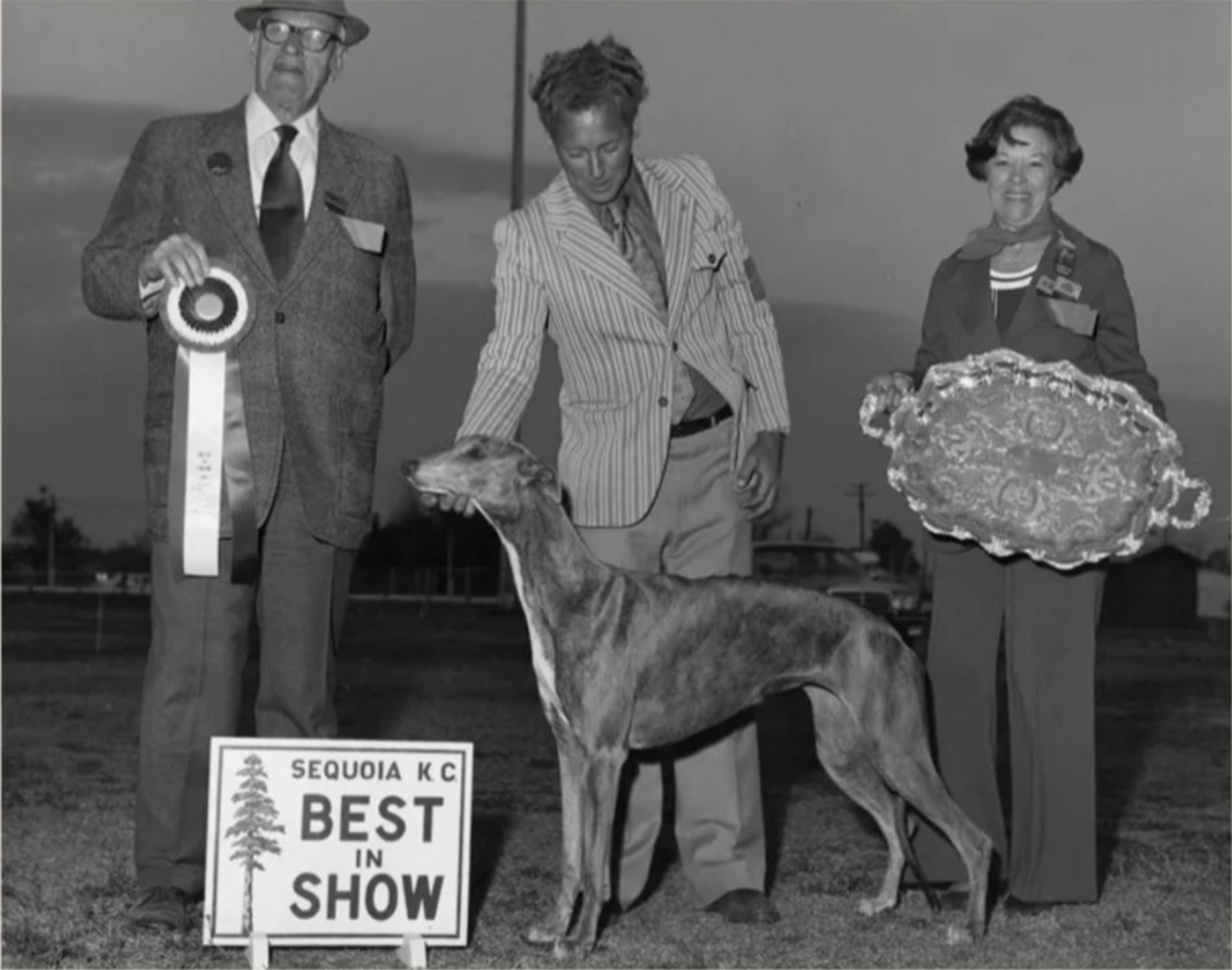
Ch. Aroi Talk of the Blues, ‘Punky’, shown with handler Corky Vroom. Judge Anne Rogers Clark “discovered” Punky in 1975, when she made her Best of Breed from the Puppy class at the Greyhound Club of America specialty in Santa Barbara. Punky was the Top Dog of all breeds in 1976.
Mary’s fantasy best in show line up would be judged by Michelle Billings. It would feature Mick, the Kerry Blue who shows up in most judges’ all-time best line ups, but many of her other choices are more esoteric and focused on dogs she knew personally. From Iron Eyes, the Bouvier to Scarlett Ribbons, the Italian Greyhound. Listen in to hear her personal choice for Best in Show.
503 – Examining the History of Sighthounds with Bo Bengtson
Examining the History of Sighthounds with Bo Bengtson
Bo Bengtson, author, publisher and Whippet breeder, attended his first dog show in 1958 in his native Sweden. He joins host Laura Reeves for a deep dive into the intricacies of sighthounds.
“It was, right away, like lightning struck,” Bengtson said. “I was 14 years old and I just knew right away that this was what I wanted to devote my life to. It was really fascinating. It was, as someone once said, a combination of zoo and circus and theater …
A passion for sighthounds
“You have to know a little bit about coursing if you’re involved in sighthounds. They have remained the same for thousands of years, the basic type. They weren’t breeds early on but different types of sighthounds. if you look at the early description of coursing which is the pursuit of game with sighthounds … that is a sport that’s now these days illegal in most of US… It’s been superseded by lure coursing, which is an artificial form of coursing.

“Hunters Homeward Bound,” 10th Century AD. Courtesy of Bo Bengston.
“(Sighthounds developed) before firearms basically, when the only way you had to hunt was through the dogs and whatever they could course and kill was basically today’s dinner. Firearms made sighthounds very much superfluous. And I think the sport then became very much a status symbol. (Sighthounds) are of course aesthetically pleasing and so many rich people and aristocratic people preferred to hunt with sighthounds, not because of need but because it was a beautiful spectacle and pretty expensive spectacle too. In various parts of the world, Queen Elizabeth I was very fond of coursing. In Russia they coursed with Borzoi. And in the Far East there were Salukis.
What IS a Sighthound?
“There is no official definition of what a sighthound is. So there is a great disagreement about what breeds actually count as sighthounds. You can count as few as four or five as pure sighthounds and as many as 40 as “sighthound related” or different types of breeds we don’t know in this country. Some we wouldn’t define as breeds but more as types.
(Listen to fascinating conversations about the Caravan Hounds of India here and here.)
History of sighthound development
“I think we have to go back again a couple of thousand years because there have probably always been different sizes of greyhounds. Greyhound types. The big ones which were the ancestor of the modern greyhound. And we have the different, smaller ones that were ancestors of whippet and the Italian greyhounds. I think that Whippets, although they weren’t described as a breed until late 1800s, they have certainly been around much longer. Catherine the Great of Russia had little English greyhounds she called them. And they were very important to her. She nursed them herself and they slept on a pink couch in her bedroom. But whether they’re Italian greyhounds, whether they were whippet, who knows. I mean they were very small and whether Italian greyhounds or whippets, it is kind of irrelevant these days.
“The Greyhound and the Saluki are sort of the “ur” sighthound, what sighthounds are supposed to be like. … if you take one step away from Saluki you get the Afghan Hound, which is a little more powerful. If you take several steps away from the Greyhound, you get the Ibizan Hound and you get the Portuguese Podengo and that kind of thing.”
Listen to the full episode for more detailed insights into all things sighthound.
359 – “Space Whippet,” Insta Celeb, Provides Social Media Tips
“Space Whippet,” Insta Celeb, Provides Social Media Tips
Beth Gordon acquired a race-bred whippet after her mixed breed rescue developed IVDD (intervertebral disc disease). Kuiper the Space Whippet’s rise to fame on social media provides a blueprint for others to follow in promoting purebred dogs.
“I wanted a healthy dog I could do sports with. It’s ok to not want a project. We’ve spent as much as my college education on our older dog with health issues. I just didn’t want to have to do that again,” Gordon said.
“I decided we needed better influencers on this new-fangled thing called Instagram, Gordon said.” She wanted to do something that was informative, not just fluffy. A “space tree” in Salem, Oregon was the idea for the launch of Kuiper the Science Dog, Space Whippet.
In just a couple years, Gordon and Kuiper have acquired more than 150,000 Instagram followers and been to Kennedy Space Center for a photo shoot for the account.
Utterly shameless self-promotion makes all the difference, Gordon said. “Business cards cost $20 and people love to get them.”
“Even though the account name is space whippet, I get a lot of questions about his breed,” Gordon said. “I think it’s a good opportunity. The way you increase representation for anything is by showing it to people, not making a big deal out of it.
“When you’ve been fed this line there are so many rescue dogs, why don’t you have a rescue dog? My answer is that purebred dogs are not fungible with rescue dogs. If my choice was another rescue dog or no dog, I just wouldn’t get a dog. If you have specific things you want to do, you’re much better to get a breed designed for that.
“The general public doesn’t know there are so many things you can do with your dog. May not consider their dog trainable. Increasing awareness of the sports they can do is so important. Purebred dogs are not just for beauty, dogs are functional,” Gordon said.


